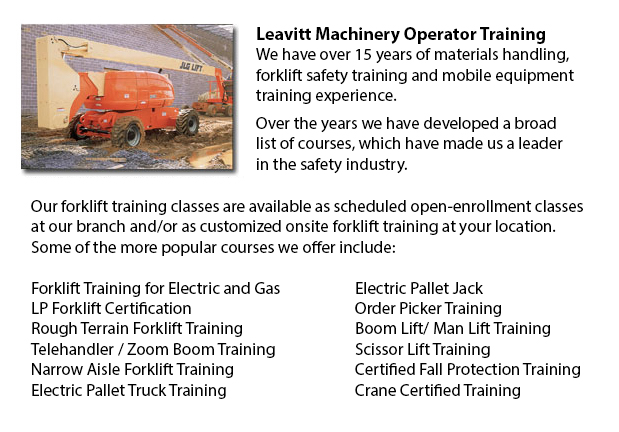
Hamilton Boom Lift Certification - The use o elevated work platforms allow for maintenance operations and work to be performed at elevated work heights that were otherwise unreachable. Boom Lift Certification Training educates workers about the safe operation of boom lifts and scissor lifts.
Despite the range in lift style, applications and site conditions, all lifts have the possibility for death or serious injury when not safely operated. Falls, electrocution, crushed body parts, and tip-overs could be the unfortunate result of incorrect operating procedures.
In order to prevent aerial lift incidents, individuals should be qualified to be able to train workers in the operation of the certain kind of aerial lift they will be making use of. Controls must be easily accessible beside or in the platform of boom lifts used for carrying workers. Aerial lifts should never be modified without the express permission of other recognized entity or the manufacturer. If you are leasing a lift, ensure that it is maintained properly. Prior to using, controls and safety devices need to be checked to be able to make sure they are functioning correctly.
It is important to follow safe operating procedures to be able to prevent workplace accidents. Driving an aerial lift while the lift is extended should not be done, nonetheless, a few models are designed to be driven when the lift is extended. Set outriggers, if available. Always set brakes. Avoid slopes, but when necessary utilize wheel chocks on slopes which do not go over the slope restrictions of the manufacturer. Follow weight and load restrictions of the manufacturer. When standing on the boom lift's platform, use a safety belt with a two-foot lanyard tied to the basket or boom or a full-body harness. Fall protection is not required for scissor lifts that have guardrails. Do not climb or sit on guardrails.
The boom lift certification course provides instruction in the following areas: safety guidelines to prevent a tip-over; training and certification; checking the work area and travel path; slopes and surface conditions; stability factors; other guidelines for maintaining stability; weight capacity; leverage; pre-operational inspection; testing control functions; mounting a vehicle; safe operating practices; safe driving procedures; power lines and overhead obstacles; PPE and fall protection; utilizing lanyards and harness; and avoiding falls from the platform.
When successful, the trained worker would be familiar with the following: authorization and training procedures; pre-operational check procedures; how to prevent tip-overs; factors affecting the stability of boom and scissor lifts; how to utilize PPE, how to utilize the testing control functions and strategies to avoid falls.
-
Hamilton Aerial Platform Training
Hamilton Aerial Platform Training - Aerial hoists are able to accommodate various odd jobs involving high and hard reaching spaces. Often utilized to perform routine repair in structures with high ceilings, prune tree branches, hoist heavy shelving u... More -
Hamilton Heavy Equipment Operator Certification
Hamilton Heavy Equipment Operator Certification - The heavy equipment operator is a person who manipulates the controls and drives different kinds of big machinery. Heavy machinery is most commonly utilized on construction sites to deliver supplies t... More -
Hamilton Scissor Lift Ticket
Hamilton Scissor Lift Ticket - Scissor lifts have greatly benefited construction operations in view of the fact that the job that used to require much effort and lots of people, can now be completed utilizing the scissor lift truck and only one indiv... More -
Hamilton Forklift Certification Courses
Hamilton Forklift Certification Courses - Forklift certification courses really help to make sure that businesses utilizing forklifts, comply with the regional and local rules. The drivers of the forklift should undergo forklift certification prior t... More -
Hamilton Forklift Training Program
Hamilton Forklift Training Program - The forklift is a common powered industrial vehicle which is in wide use these days. They are occasionally called jitneys, hi los or lift trucks. A departments store would use the forklift to unload and load merch... More -
Hamilton Forklift License
Hamilton Forklift License - Obtaining a forklift license or forklift certification in North America would require the trainee to do hands-on training in addition to classroom instruction. The state, provincial and federal regulatory bodies are respon... More -
Hamilton Manlift Operator Certification
Hamilton Manlift Operator Certification - Our aerial lift and scissor platform training and certification empowers participants with a general understanding and knowledge of the efficient and safe use of "Power Operated Mobile Work Platforms," under... More -
Hamilton Forklift Operator Certification
Hamilton Forklift Operator Certification - Forklift operator certification is usually needed for employees working in industrial, warehouse or construction setting to guarantee the safe utilization of forklifts. Workplace training has to follow a met... More

Forklift Certification Hamilton
TOLL FREE: 1-888-254-6157
Hamilton, Ontario
forkliftcertificationhamilton.com
Email Us
About Us


